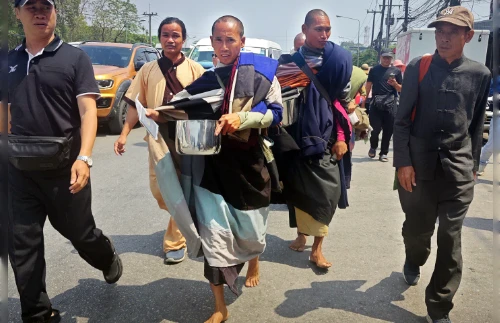
The school year for children living in Tibetan areas of China has started under harsh new restrictions, with children in one Qinghai county ordered by authorities out of their homes and into Chinese boarding schools, and the language of classroom instruction in another county switched from Tibetan to Chinese, Tibetan sources say.
In several towns in Qinghai’s Rebgong (in Chinese, Tongren) county, local primary schools have been closed by government order, and Tibetan children are being forced against their parents’ wishes into boarding schools in areas far away, a local source told RFA’s Tibetan Service this week.
“The Tibetan parents have appealed to Chinese authorities not to separate their children from them by sending them off to other regions for schooling,” RFA’s source said, speaking on condition of anonymity. “And when the authorities did not heed their request, some of them staged a protest.”
The parents’ protest quickly triggered a crackdown by police, with police vehicles and blaring sirens responding quickly to the protest scene, and one male protester was taken into custody, the source said.
“Several children at the protest were so frightened by all the commotion that they fainted,” the source said, adding that the children’s parents were finally forced to send their children away to the Chinese government-designated boarding schools.
The single protester taken into custody was later released, he said.
Classes taught only in Chinese
In Qinghai’s Themchen (in Chinese, Tianjun) county, two middle schools in the Bongtak area were meanwhile merged, forcing Tibetan schoolchildren into classes taught only in Chinese and following a similar merger of nearby primary schools, another local source told RFA.
“Previously, Tibetan parents had a choice of sending their children to a Tibetan-language or a Mandarin-language school, and the Tibetans would send their children to the Tibetan schools,” RFA’s source said, also speaking on condition his name not be used.
“But now most of these schools have been merged, creating ethnically mixed classes, which is a huge concern for us,” the source said.
“The Tibetan language itself is now the only subject taught in Tibetan, leaving Mandarin as the medium of instruction for all the other subjects taught in school,” the source said, adding that the move appears aimed at implementing China’s new policy of eroding language rights to destroy minority cultures.
The enactment of similar policies in China’s Inner Mongolia region have led in recent weeks to widespread protests and boycotts of the schools, with hundreds of ethnic Mongolians arrested or forced to resign from public office after they resisted the changes to the curriculum, which were kept under wraps until the start of the new semester at the end of August.
China’s Regional Ethnic Autonomy Law says that agencies in ethnic autonomous areas have the right to make decisions about education, including the language used in classroom instruction, said U.S.-based China analyst Ganze Kyab Lama.
“But many restrictive policies have now gained momentum under the leadership of Chinese president Xin Jinping as local officials look after their own political advantage and gain,” Kyab said.
Language rights have become a particular focus for Tibetan efforts to assert national identity in recent years, with informally organized language courses in the monasteries and towns typically deemed “illegal associations” and teachers subject to detention and arrest, sources say.
Reported by Chakmo Tso and Dorjee Tso for RFA’s Tibetan Service. Translated by Dorjee Damdul. Written in English by Richard Finney.
Copyright © 1998-2020, RFA. Used with the permission of Radio Free Asia, 2025 M St. NW, Suite 300, Washington DC 20036. https://www.rfa.org
UN Security Council Meets on Situation in Middle East, Including Palestinian Question
Remote Island’s Brain-Damaged Seabirds Show Far-Reaching Impact of Plastic Pollution
New Zealand Police Stopped Naked Driver
Dog Stories
They Are Not Journalists But Propagandists
Cryptojacking
Chinese Man Who Displayed Pro-Democracy Banners in Detention:Sources
United Nations High Commissioner for Refugees Briefs Press
Subscribe Our You Tube Channel
Fighting Fake News
Fighting Lies


















